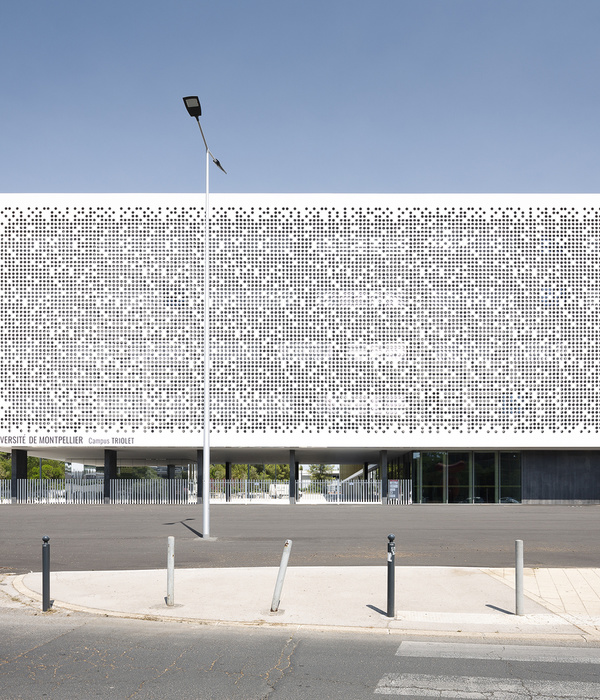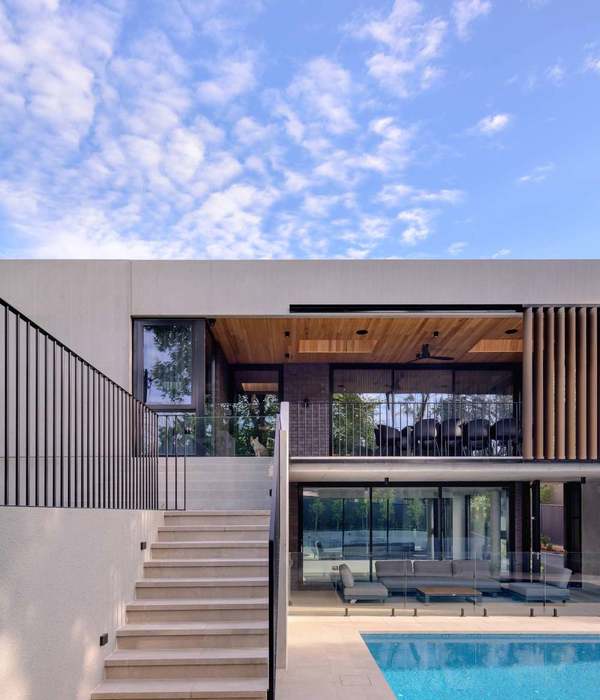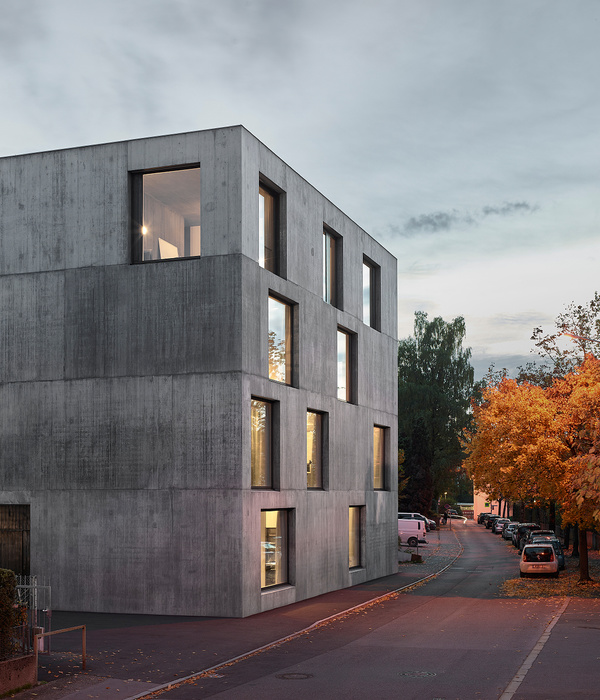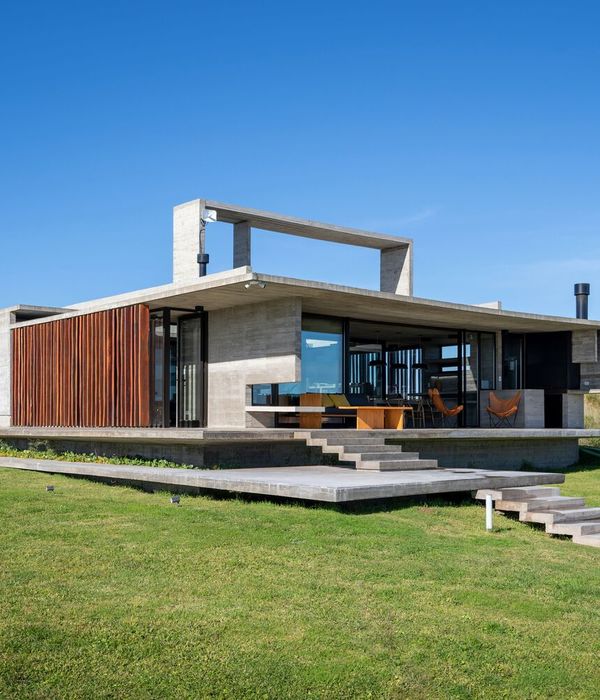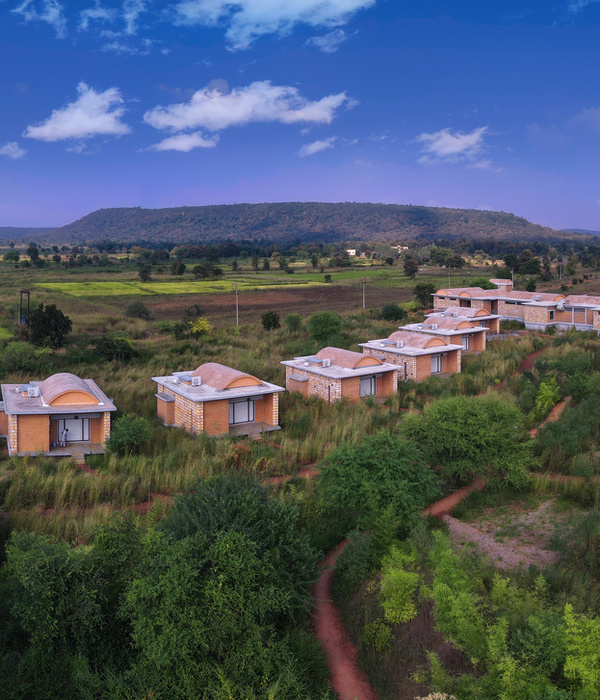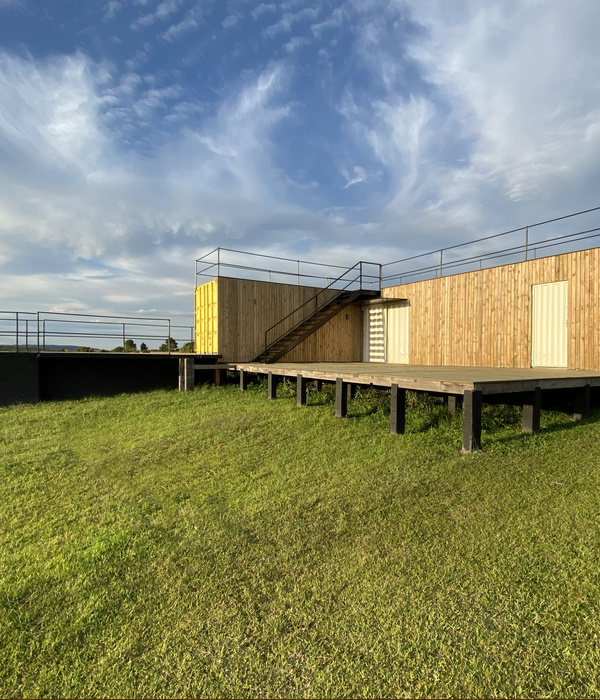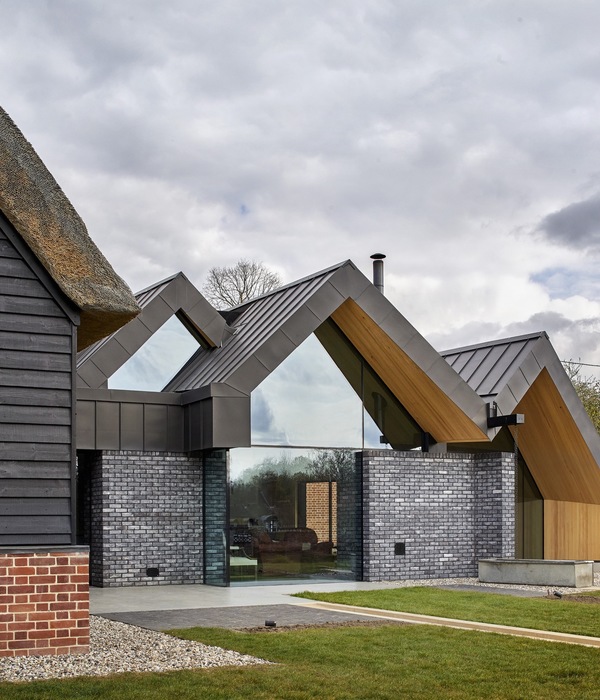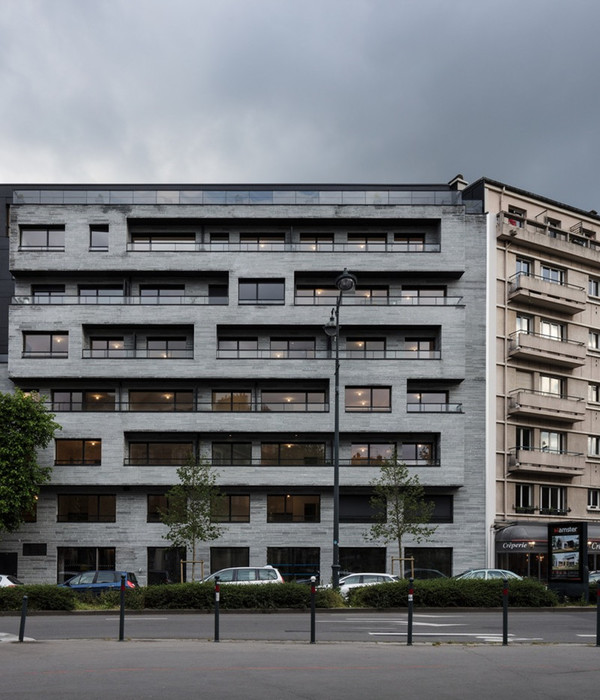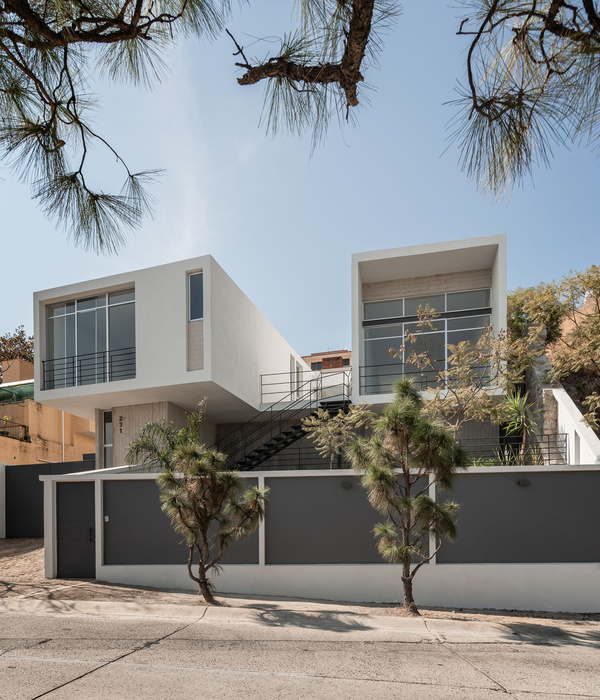- 项目名称:小石村文化大院及小石村整体规划
- 项目类型:公共建筑
- 项目地点:四川省彭州市小石村
- 设计单位:时地建筑工作室
- 主持建筑师:李烨
- 设计团队:张苗,王智,岳野,曾宪明,何茜(实习)
- 业主:彭州市小石社区村委会
- 项目造价:93万
- 建成状态:建成
- 结构顾问:赵静涛
- 机电顾问:郭英明
- 策划顾问:黄和璐
- 规划顾问:吴焕
- 社区治理顾问:岳付飞
- 驻场建筑师:岳野,曾宪明,张寻,杨丽君
- 主要材料:混凝土框架,钢结构(屋面),水刷石(外墙),小青瓦
- 摄影:何炼(直译建筑)
- 媒体顾问:俞怡人 (Yú多媒体设计工作室)
在2017年,我们应村书记的邀请对四川彭州小石村进行了一系列的建筑设计与整体规划。如同其他龙门山区震后重建的村落一样,小石村面临着身份重塑的困境。我们看到的是面貌相似的居民点、简陋的沿街砖混建筑、以及空心化的农村社区。
In 2017, we were invited by the village secretary to do an overall planning and a series of architectural design of Xiaoshi Village in Pengzhou, Sichuan Province. Just like other rebuilt villages after the earthquake, XIaoshi Village is facing the same difficulty in reidentifying itself with monotonous residential buildings, simple brick-concrete architecture along the street and hollowing rural community.
▼小石村鸟瞰,aerial view of Xiaoshi Village
四川的偏阴气候,使大多数人喜爱在开敞的室外活动;全年的降水量很大,人们又习惯性地需要遮蔽。当地人和公共环境这种有韧性的相处方式,形成了传统的坡屋顶和大量开敞檐廊的建筑形式,也形成了“共同生活”的场所基础。而现代的快速建筑代替了传统空间形式的同时,也破坏了藉由传统空间而形成的生活习惯,却并未回答:未来的社区应该具有怎样的空间品质?应该如何构建一种共同生活的空间协议?
由此引发了我们最本能的想法:营造一个“包容一切活动的瓦屋顶”,籍此去连接诗性的传统与互联的未来社区。既营造了“同在屋檐下”的一种身份认同,又让人们走出来、让行为发生、从空间层面进行软性的公共治理,从而逐渐孵化出未来的乡村社区模型。
Overcast weather dominates the weather in Sichuan area with quite plenty annual rainfall, which make local people enjoy outdoor activities in open spaces with proper shadings. To live in harmony with the natural environment, traditional local architecture usually has a pitched roof and open corridors, where locates people’s local common life. We observed the destroy of traditional form of spaces and local lifestyle caused by modern fast-built architecture and tried to answer retain the quality of space and common lifestyle in future communities?
Our instinct idea is to do soft improvement from the aspect of space: build one tile roof to contain all the activities, which will attract people to go out and interact, and also connect the poetic tradition with interlinked future community. A new identity of ‘Live Together under One Roof’ is then created and will gradually incubate a model rural community for the future.
▼鸟瞰文化大院与小石村中的新居民楼,营造一个“包容一切活动的瓦屋顶”以连接传统与未来社区,aerial view of the Cultural Center with new residential buildings at back, creating one tile roof to contain all the activities to connect the tradition with future community
小石村文化大院项目是我们的第一个建筑实验。位于小石村的中心,文化大院包含了日间照料中心、乡村卫生站、乡村夜校、健身房、忠孝文化展厅等多重公共功能,正是一个可以塑造理想的公共空间模式的开端。文化大院的设计用一个占满用地范围的四坡瓦屋顶来统领结构、材料、细节和功能的发展。我们在屋顶的四坡分别打开四处天井,和一层分居四处的辅助空间相互呼应,为屋檐下的入口营造了看似无意识但十分流畅的进入方式;修茂的竹子从天井中生长出来,为一层核心空间和二层各房间提供景观和与自然的亲密度。
The Community Cultural Center is our first architectural experiment. Located at the heart of XIaoshi Village, the building compound contains multiple common programs including: Day Care Center, Rural Clinic, Night School, Gym, ‘Loyalty and Filial Piety’ Cultural Exhibition Hall and etc., which is a perfect start to test out our ideal mode of future common space. The featured design of our Cultural Center is a hip roof to cover the whole site and lead the development of structure, materials, details and programs. Responding to four separated auxiliary spaces on first floor, we place one open courtyard each on four sides of the roof for natural access under the eave. Tall and dense bamboos planted in these courtyards form a characteristic landscape for the main space on first floor and other rooms on second floor.
▼文化大院二层平台鸟瞰,在屋顶的四坡分别打开四处天井,aerial view of the platform on the second floor, placing one open courtyard each on four sides of the roof
▼西面广场可通往建筑的次入口,修茂的竹子从天井中生长出来,a small square connected to the secondary entrance, planting tall and dense bamboos in the courtyards
▼西面二层室外平台,outdoor platform on the second floor at west side
为实现屋檐处8米的悬挑,采用了混凝土梁挑钢梁的形式;屋面下再用处理过的细竹吊顶,提供一种温暖的尺度和微妙的光线折射。与此相对应的,建筑的外墙采用了黑石子水刷石的处理,地面采用素混凝土打磨,目的是将光线控制在一个明净柔和的状态,从而使屋顶的尺度与人的关系更加明确。墙面水磨石的尺度和分格,暗示了竹节的纹样,与屋顶和天井景观构成了自然、人工、抽象,三种竹意向的对话。
▼文化大院东面夜景,建筑的外墙采用了黑石子水刷石的处理,night view of east side, the exterior wall is coated with black rustic stone
▼沿街面主入口,墙面水磨石的尺度和分格暗示了竹节的纹样,main entrance along the street, the scale and division of rustic-stone coating also indicate the pattern of bamboo joints
▼通往文化大院的石阶,屋面下用处理过的细竹吊顶,stone steps connect to the compound of Cultural Center, using treated bamboo as the material for ceiling
We apply the combination of concrete beam and steel beam to realize the 8-meter-long cantilever of the roof; use treated bamboo as the material for ceiling to create a warm feeling of interior scale and subtle refractions of light. While at the outside, the exterior wall is coated with black rustic stone and the floor is polished with plain concrete, aiming to clarify the scale between the roof and people by clear but soft light. The scale and division of rustic-stone coating also indicate the pattern of bamboo joints, forming an interesting dialogue among natural, artificial and abstract bamboo, together with the courtyard landscape and interior ceiling.
▼室内的人工细竹吊顶,interior artificial bamboo ceiling
从2018年建筑建成起,我们对“同在屋檐下”的公共空间模式持续观察了一年,这里常会成为村民自发活动的中心区,也逐渐成为小石村对外的形象标志物。在我们对村社区未来的规划里,将以此为中心引发一系列互联互通的、结合生产与生活方式的屋顶空间,最终形成我们理想的乡村社区空间模型。
▼檐廊下带遮蔽的户外空间,shaded corridor space with wide-spread roof
▼修茂的竹子穿破屋顶,tall and dense bamboos grow out from the courtyard to the roof
After the complete of Community Cultural Center in 2018, we stay in the neighborhood and observe the experimental mode of common space ‘Live Together under One Roof’ for one year: this building compound is often the first choice for local activities and gradually becoming the iconic architecture of Xiaoshi Village. In our future plan of this rural community, the Center will trigger series design of interlinked roof spaces to integrate production and living, and will form our ideal mode of rural community in the end.
▼夏天附近居民自然地聚集在屋檐下乘凉,residents naturally gather togerther under the roof in summer
▼位于一层中心的活动室,activities room at the center of first floor
▼小时村平面规划总图,overall plan of Xiaoshi Village
▼总平面图,master plan
▼一层平面图,1F plan
▼二层平面图,2F plan
▼北立面图,north facade
▼西立面图,west facade
▼东立面图,east facade
▼南立面图,south facade
▼A-A剖面图,A-A section
▼1-1剖面图,1-1 section
▼大样图,details
项目名称:小石村文化大院及小石村整体规划
项目类型:公共建筑
项目地点:四川省彭州市小石村
设计单位:时地建筑工作室
主持建筑师:李烨
项目主管/项目建筑师:李烨
设计团队:张苗、王智、岳野、曾宪明、何茜(实习)
业主:彭州市小石社区村委会
项目造价:93万
建成状态:建成
设计时间(起讫时间):2017.6-2017.9
建设时间(起讫时间):2017.10-2018.9
用地面积(平方米):625
建筑面积(平方米):650
结构顾问:赵静涛
机电顾问:郭英明
策划顾问:黄和璐
规划顾问:吴焕
社区治理顾问:岳付飞
驻场建筑师:岳野、曾宪明、张寻、杨丽君
主要材料:混凝土框架、钢结构(屋面)、水刷石(外墙)、小青瓦
摄影:何炼(直译建筑)
媒体顾问:俞怡人 (Yú多媒体设计工作室)
Project Name: Community Cultural Center, Series Projects of Xiaoshi Village Overall Planning
Type: Public Architecture
Location: Xiaoshi Village, Pengzhou, Sichuan Province, China
Design: Studio Dali Architects
Design Principal: Li Ye
Project Leader/Project Architect: Li Ye
Design Team: Zhang Miao, Wang Zhi, Yue Ye, Zeng Xianming, He Qian (Intern)
Client: Cummunity Committee of Xiaoshi Village
Cost: 930,000 RMB
Status: Built
Design Stage (Start-End): June – September, 2017
Construction Stage (Start-End): October 2017 – September 2018
Site Area (sqm): 625
Building Area (sqm): 650
Structure Consultant: Zhao Jingtao
M&E Consultant: Guo Yingming
Organizing Consultant: Huang Helu
Planning Consultant: Wu Huan
Community Building Consultant: Yue Fufei
Construction Service: Yue Ye, Zeng Xianming, Zhang Xun, Yang Lijun
Main Material: Reinforced concrete frame, steel structure (roof), rustic stone coating (exterior wall), grey tile
Photopraphy: He Lian (Transliterate Architects)
Media Consultant: Freda Yu (Atelier Yú)
{{item.text_origin}}


